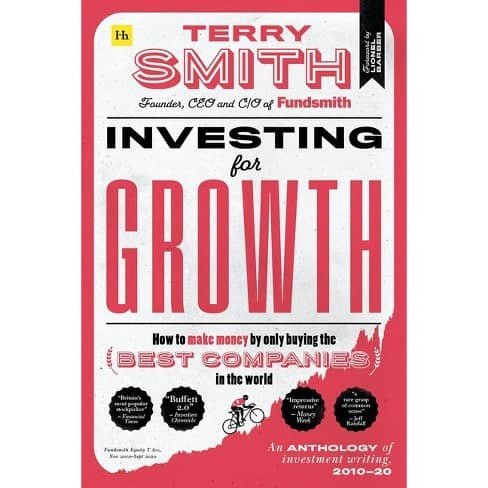Terry Smith was born on May 30, 1953, in a small town in Essex, England. He is a well-known British fund manager and entrepreneur. He attended Alleyn’s School in Dulwich, London, and later studied history at University College Cardiff. Terry Smith is the founder of Fundsmith, an investment management firm that specializes in global equity investing. He is known for his “growth investing” strategy, which involves identifying companies that have the potential for sustained and profitable growth over the long term.
Fundsmith has since become one of the most successful investment firms in the UK, with several high-performing funds that have consistently outperformed the market. Smith’s approach to growth investing has won him numerous accolades and awards, including the title of “Fund Manager of the Year” at the Morningstar Awards in 2017 and 2018.
Terry Smith Professional Career and Net Worth
Smith began his career as an accountant, working for Touche Ross & Co (now Deloitte) before moving into investment banking. He worked for several investment banks, including UBS and Barclays, before joining Collins Stewart in 2000, where he served as CEO from 2003 to 2006.
In 2010, Smith founded Fundsmith, an investment management firm that specializes in global equities.The firm’s flagship Fundsmith Equity Fund has been highly successful, outperforming its benchmark index and winning numerous awards. Smith is known for his outspoken views on the financial industry and has been critical of high fees and opaque investment products. He has also been an advocate for greater transparency and accountability in the industry.
As per the Sunday Times Rich List, Terry Smith is estimated to be worth at least $260 million.
Terry Smith Investment Strategy
Terry Smith’s investing strategy is focused on investing in high-quality companies with a sustainable competitive advantage and a long-term growth potential. He believes that investing in such companies can generate superior returns over the long term, and that the key to successful investing is to identify these companies and hold them for the long term.
Smith’s investment philosophy is based on a set of principles that he calls the “Fundsmith Stewardship Principles.” These principles include:
Invest in good companies: Smith believes in investing in companies that have a track record of generating high returns on capital, have a strong competitive position in their industry, and have a durable business model.
Don’t overpay: Smith believes in investing at a fair price and avoiding companies that are overvalued. He uses a variety of valuation metrics, including price-to-earnings ratios, price-to-sales ratios, and price-to-cash flow ratios, to determine a company’s intrinsic value.
Do nothing: Smith believes in the power of compounding and the importance of holding investments for the long term. He advises against frequent trading or trying to time the market, and instead recommends holding a concentrated portfolio of high-quality companies for the long term.
Be transparent: Smith believes in transparency and accountability, both for himself and the companies in which he invests. He emphasizes the importance of honest and open communication with investors and of investing in companies with strong corporate governance practices.
In summary, Terry Smith’s investing strategy is focused on identifying high-quality companies with a sustainable competitive advantage and holding them for the long term. He believes that investing in such companies at a fair price can generate superior returns over the long term and that transparency and accountability are essential to successful investing.
Terry Smith Books
Terry Smith has written several books on finance, investing, and business. Some of his notable books include:
- Accounting for Growth – In this book, Smith argues that traditional accounting methods fail to adequately reflect the true value of a company’s assets and earnings potential.
- Investing for Growth: A Practical Guide to Business Finance – In this book, Smith provides a comprehensive guide to investing in growth stocks and highlights his investment strategy.
- The Wealth Creators- This book examines the factors that contribute to successful businesses and the creation of wealth.
- The Art of Execution: How the World’s Best Investors Get it Wrong and Still Make Millions – In this book, Smith explores the importance of investment execution and provides insights into how successful investors make money in the stock market.
- Globalisation: The Rascal’s Return- In this book, Smith argues that globalization has been a force for good, despite the negative effects it has had on some individuals and communities.
Key Takeaways/Summary of the Book ‘Investing for Growth’
Terry has divided the book into 7 chapters. We have provided a brief summary of each of the chapters below.
Chapter 1: Investing for Growth
The first chapter of the book lays out the basic principles of investing for growth. Terry Smith argues that investing in stocks for long-term growth is the most effective way to create wealth. He stresses the importance of understanding the underlying business of a company before investing in its stock, and highlights the benefits of investing in high-quality companies that have a sustainable competitive advantage.
Chapter 2: Finding the Right Stocks to Invest In
In this chapter, Terry Smith discusses how to identify high-quality companies that are likely to provide long-term growth. He emphasizes the importance of analyzing a company’s financials, including its revenue growth, earnings, cash flow, and debt levels. He also discusses how to evaluate a company’s management team and its competitive position within its industry.
Chapter 3: Portfolio Construction
The third chapter of the book focuses on portfolio construction. Terry Smith argues that investors should focus on building a concentrated portfolio of high-quality stocks rather than a diversified portfolio of mediocre stocks. He also discusses how to manage risk in a concentrated portfolio and the importance of staying disciplined and sticking to your investment strategy.
Chapter 4: Fundamentals of Valuation
In this chapter, Terry Smith explains the fundamentals of stock valuation. He discusses different valuation metrics, such as price-to-earnings ratios, price-to-sales ratios, and price-to-book ratios, and explains how to use them to determine whether a stock is overvalued or undervalued. He also discusses the importance of using a company’s free cash flow to calculate its intrinsic value.
Chapter 5: The Art of Selling
The fifth chapter of the book focuses on the art of selling stocks. Terry Smith argues that selling a stock is just as important as buying it, and that investors should have a clear exit strategy before they invest. He also discusses how to recognize when it’s time to sell a stock, and the importance of staying disciplined and not becoming emotionally attached to your investments.
Chapter 6: The Market and the Economy
In this chapter, Terry Smith discusses the relationship between the stock market and the economy. He argues that the stock market is not a good indicator of the overall health of the economy, and that investors should focus on the fundamentals of individual companies rather than trying to time the market.
Chapter 7: The Psychology of Investing
The final chapter of the book focuses on the psychology of investing. Terry Smith discusses the common biases and emotions that can lead investors astray, such as overconfidence, herd mentality, and loss aversion. He also offers advice on how to stay disciplined and avoid making emotional investment decisions.
Thus, Investing for Growth provides a comprehensive guide to investing in stocks for long-term growth, based on Terry Smith’s experience and investing philosophy. It offers practical advice on how to identify high-quality companies, construct a concentrated portfolio, value stocks, manage risk, and stay disciplined in the face of market volatility and emotional biases.
Read More:
John Bogle, The Little Book of Common Sense Investing Book Summary
Joel Greenblatt, The Little Book That Beats The Market Summary

